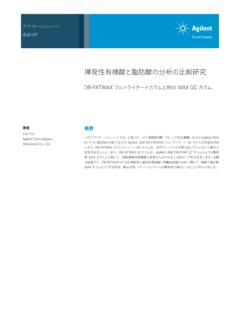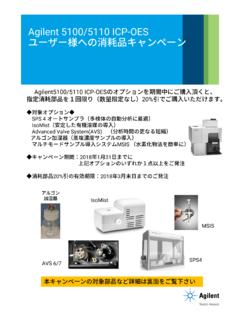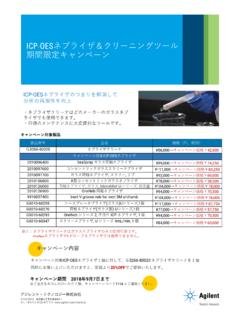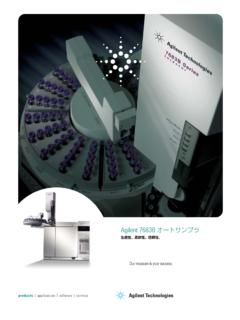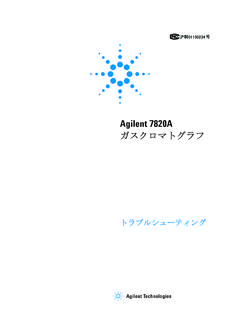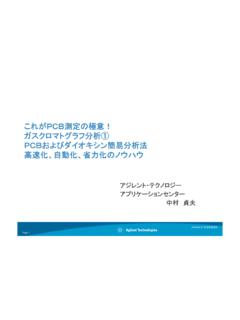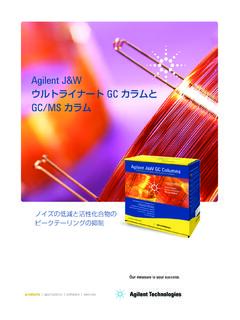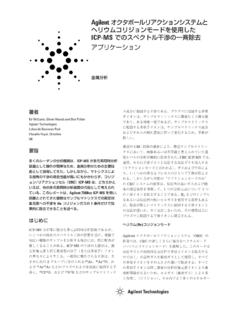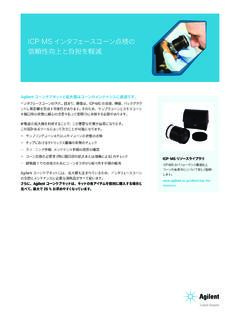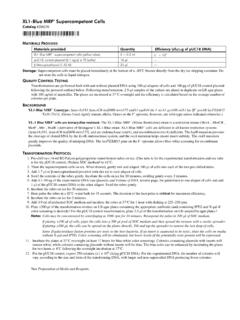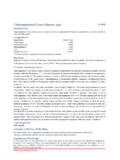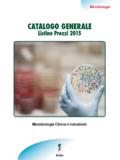Transcription of Manual: XL10-Gold® Ultracompetent Cells
1 *XXXXXX____XXXXXXX*LotPage 1 of 2 Full activity is guaranteed through two Number200314 Product NameXL10-Gold Ultracompetent Cells Materials ProvidedXL10-Gold Ultracompetent Cells (yellow tubes), 5 100 lpUC18 control plasmid ( ng/ l in TE buffer), 10 lXL10-Gold -Mercaptoethanol ( -ME) mix, 50 lCertified ByNameQuality Controlled By NameShipping ConditionsShipped on dry ConditionsUltracompetent Cells must be placed immediately at the bottom of a -80 C freezer directly from the dry ice shipping container. Do not store the Cells in liquid nitrogen. Ultracompetent Cells are sensitive to even small variations in temperature. Transferring tubes from one freezer to another may result in a loss of Efficiency 5 109 cfu/ g pUC18 DNATest ConditionsTransformations are performed both with and without plasmid DNA using 100- l aliquots of Cells and 10 pg of pUC18 control DNA following the protocol outlined below. Following transformation, 5- l samples of the culture are plated in duplicate on LB agar plates with 100 g/ml ampicillin.
2 The plates are incubated at 37 C overnight and the efficiency is calculated based on the average number of colonies per ResistanceXL10-Gold Cells are tetracycline and chloramphenicol resistant. Genotype and BackgroundTetrD(mcrA)183 D(mcrCB-hsdSMR-mrr)173 endA1 supE44 thi-1 recA1 gyrA96 relA1 lac Hte [F proAB lacIqZDM15 Tn10 (Tetr) Amy Camr]. (Genes listed signify mutant alleles. Genes on the F episome, however, are wild-type unless indicated otherwise.)XL10-Gold* Ultracompetent Cells were created for transformation of large DNA molecules with high efficiency. These Cells exhibit the Hte phenotype, which increases the transformation efficiency of ligated and large DNA molecules. XL10-Gold Ultracompetent Cells are ideal for constructing plasmid DNA libraries because they decrease size bias and produce larger, more complex plasmid libraries. XL10-Gold Cells are deficient in all known restriction systems [D(mcrA)183 D(mcrCB-hsdSMR-mrr)173]. The strain is endonuclease deficient (endA), greatly improving the quality of miniprep DNA, and recombination deficient (recA), helping to ensure insert stability.
3 The lacIqZDM15 gene on the F episome allows blue-white screening for recombinant Protocol 1. Pre-chill two 14-ml BD Falcon polypropylene round-bottom tubes on ice. (One tube is for the experimental transformation and one tube is for the pUC18 control.) Preheat NZY+ broth to 42 C. 2. Thaw the Cells on ice. When thawed, gently mix and aliquot 100 l of Cells into each of the two pre-chilled tubes. 3. Add 4 l of the -ME mix provided with this kit to each aliquot of Cells . 4. Swirl the tubes gently. Incubate the Cells on ice for 10 minutes, swirling gently every 2 minutes. 5. Add ng of the experimental DNA (or 2 l of a ligation mixture) to one aliquot of Cells . Dilute the pUC18 control DNA 1:10 with sterile dH2O, then add 1 l of the diluted pUC18 DNA to the other aliquot of Cells . 6. Swirl the tubes gently, then incubate the tubes on ice for 30 minutes. 7. Heat-pulse the tubes in a 42 C water bath for 30 seconds. The duration of the heat pulse is critical. 8. Incubate the tubes on ice for 2 minutes.
4 9. Add ml of preheated (42 C) NZY+ broth and incubate the tubes at 37 C for 1 hour with shaking at 225-250 Plate 200 l of the transformation mixture on LB agar plates containing the appropriate antibiotic (and containing IPTG and X-gal if color screening is desired). For the pUC18 control transformation, plate 5 l of the transformation on LB-ampicillin agar Incubate the plates at 37 C overnight. If performing blue-white color screening, incubate the plates at 37 C for at least 17 hours to allow color development (color can be enhanced by subsequent incubation of the plates for 2 hours at 4 C). 12. For the pUC18 control, expect 250 colonies ( 5 109 cfu/ g pUC18 DNA). For the experimental DNA, the number of colonies will vary according to the size and form of the transforming DNA, with larger and non-supercoiled DNA producing fewer Color ScreeningBlue-white color screening for recombinant plasmids is available when transforming this host strain (containing the lacIqZDM15 gene on the F episome) with a plasmid that provides -complementation ( Stratagene s pBluescript II).
5 When lacZ expression is induced by IPTG in the presence of the chromogenic substrate X-gal, colonies containing plasmids with inserts will be white, while colonies containing plasmids without inserts will be blue. If an insert is suspected to be toxic, plate the Cells on media without X-gal and IPTG. Color screening will be eliminated, but lower levels of the potentially toxic protein will be expressed in the absence of 2 of 2 Critical Success Factors and TroubleshootingUse of 14-ml BD Falcon polypropylene round-bottom tubes: It is important that 14-ml BD Falcon polypropylene round-bottom tubes (BD Biosciences Catalog #352059) are used for the transformation protocol, since other tubes may be degraded by -mercaptoethanol. In addition, the duration of the heat pulse has been optimized using these Cells : Keep the Cells on ice at all times during aliquoting. It is essential that the polypropylene tubes are placed on ice before the Cells are thawed and that the Cells are aliquoted directly into pre-chilled tubes.
6 It is also important to use 100 l of Cells per transformation. Decreasing the volume will reduce of -Mercaptoethanol ( -ME): -ME has been shown to increase transformation efficiency. The -ME mixture provided is diluted and ready to use. Stratagene cannot guarantee results with -ME from other of NZY+ Broth: Transformation of the supplied Ultracompetent Cells has been optimized using NZY+ as the medium for outgrowth following the heat pulse. Substitution with another outgrowth medium may result in a loss of and Volume of DNA: The greatest efficiency is obtained from the transformation of 1 l of ng/ l supercoiled pUC18 DNA per 100 l of Cells . When transforming a ligation mixture, add 2 l of the ligation mixtureper 100 l of Cells . A greater number of colonies may be obtained by transforming up to 50 ng DNA, although the resulting efficiency (cfu/ g) may be lower. The volume of the DNA solution added to the reaction may be increased to up to 10% of the reaction volume, but the transformation efficiency may be Pulse Duration and Temperature: Optimal transformation efficiency is observed when Cells are heat-pulsed at 42 C for 30 seconds.
7 Efficiency decreases sharply when Cells are heat-pulsed for <30 seconds or for >40 seconds. Do not exceed 42 the Transformation Mixture: If plating <100 l of Cells , pipet the Cells into a 200 l pool of medium and then spread the mixture with a sterile spreader. If plating 100 l, the Cells can be spread on the plates directly. Tilt and tap the spreader to remove the last drop of Cells . If desired, Cells may be concentrated prior to plating by centrifugation at1000 rpm for 10 minutes followed by resuspension in 200 l of NZY+ of Media and ReagentsNZY+ Broth (per Liter)10 g of NZ amine (casein hydrolysate) 5 g of yeast extract 5 g of NaCl Add deionized H2O to a final volume of 1 liter Adjust to pH using NaOH and then autoclaveAdd the following filer-sterilized supplements prior to use: ml of 1 M MgCl2 ml of 1 M MgSO4 20 ml of 20% (w/v) glucose (or 10 ml of 2 M glucose) LB Agar (per Liter)10 g of NaCl10 g of tryptone 5 g of yeast extract20 g of agarAdd deionized H2O to a final volume of 1 literAdjust pH to with 5 N NaOH and then autoclavePour into petri dishes (~25 ml/100-mm plate)LB-Ampicillin Agar (per Liter)1 liter of LB agar, autoclaved and cooled to 55 CAdd 10 ml of 10 mg/ml filter-sterilized ampicillinPour into petri dishes (~25 ml/100-mm plate)Plates for Blue-White Color Screening Prepare the LB agar and when adding the antibiotic, also add 5-bromo-4-chloro-3-inodlyl- -D-galactopyranoside (X-gal) to a final concentration of 80 g/ml [prepared in dimethylformamide (DMF)] and isopropyl-1-thio- -D-galactopyranoside (IPTG) to a final concentration of 20 mM (prepared in sterile dH2O).
8 Alternatively, 100 l of 10 mM IPTG and 100 l of 2% X-gal may be spread on solidified LB agar plates 30 minutes prior to plating the transformations. (For consistent color development across the plate, pipet the X-gal and the IPTG into a 100- l pool of SOC medium and then spread the mixture across the plate. Do not mix the IPTG and the X-gal before pipetting them into the pool of SOC medium because these chemicals may precipitate.)Limited Product WarrantyThis warranty limits our liability to replacement of this product. No other warranties of any kind, express or implied, including, without limitation, implied warranties of merchantability or fitness for a particular purpose, are provided by Stratagene. Stratagene shall have no liability for any direct, indirect, consequential, or incidental damages arising out of the use, the results of use, or the inability to use this * Patent Nos. 5,512,468 and 5,707,841, 6,706,525 and patents pending and equivalent foreign and XL10-Gold are registered trademarks of Stratagene in the United in vitro use only.
9 This certificate is a declaration of analysis at the time of manufacture.
